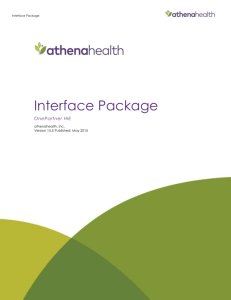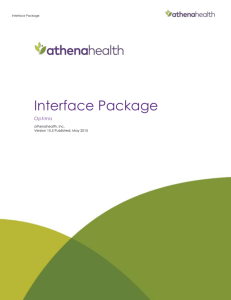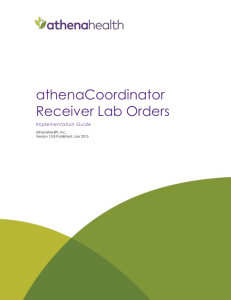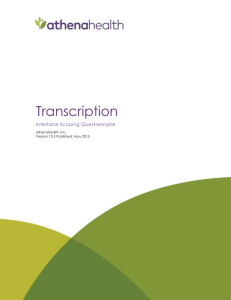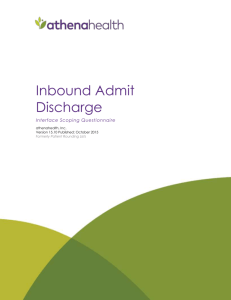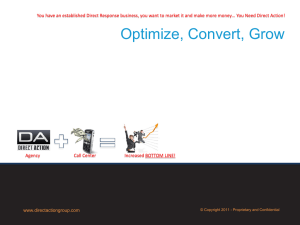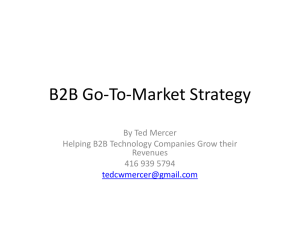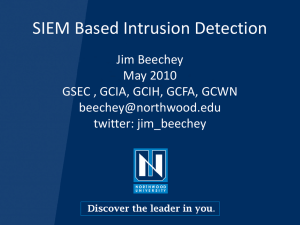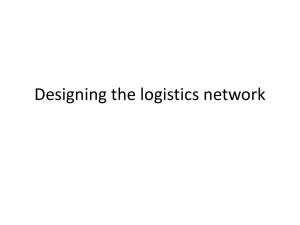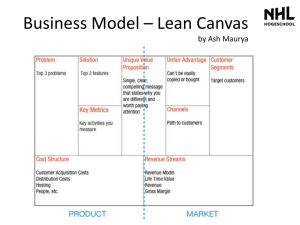Outbound Patients and Chart Data
advertisement
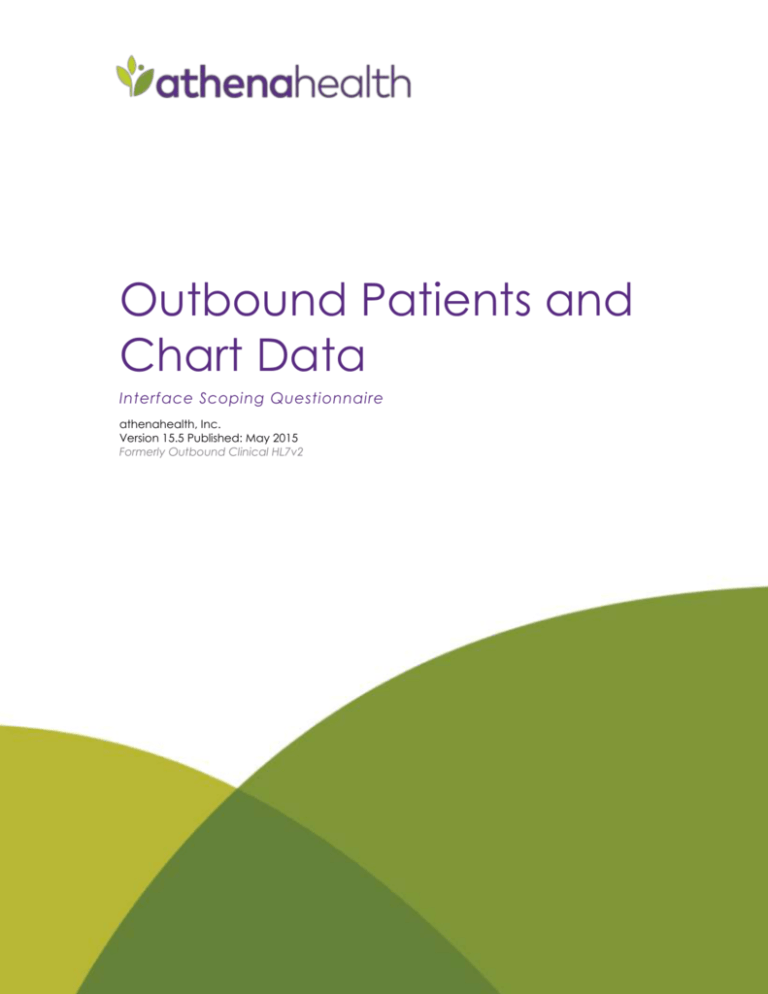
Outbound Patients and Chart Data Interface Scoping Questionnaire athenahealth, Inc. Version 15.5 Published: May 2015 Formerly Outbound Clinical HL7v2 Outbound Patients and Chart Data 1 Table of Contents 1 TABLE OF CONTENTS ........................................................................................................................................................... 2 2 COMPLETING THIS DOCUMENT.......................................................................................................................................... 4 2.1 ICONS GLOSSARY..................................................................................................................................................................... 4 2.2 SCOPING OPTIONS ................................................................................................................................................................... 4 2.3 SCOPE APPROVAL.................................................................................................................................................................... 4 3 PROJECT INFORMATION .................................................................................................................................................... 5 4 PRODUCT DESCRIPTION...................................................................................................................................................... 6 5 GENERAL INTERFACE CONFIGURATION............................................................................................................................ 7 5.1 INTEGRATION TESTING ENVIRONMENT ......................................................................................................................................... 7 5.1.1 Testing Phases and Resource Allocation ............................................................................................................ 7 5.2 MESSAGE FORMATS & SYSTEMS ................................................................................................................................................. 7 5.3 MESSAGE SAMPLES AND SPECS ................................................................................................................................................. 7 5.4 INTERFACE WORKFLOW............................................................................................................................................................. 8 5.4.1 Patients ................................................................................................................................................................... 8 5.4.2 Encounters .............................................................................................................................................................. 8 5.4.3 Episodic Clinical Data ........................................................................................................................................... 8 5.4.4 Problems ................................................................................................................................................................. 8 5.4.5 Allergies .................................................................................................................................................................. 9 5.4.6 Medications ........................................................................................................................................................... 9 5.4.7 Vaccines................................................................................................................................................................. 9 5.4.8 Order Notifications ................................................................................................................................................ 9 5.4.9 Lab Results ............................................................................................................................................................ 10 5.4.10 Patient Cases ..................................................................................................................................................... 10 5.5 EXTERNAL ID MANAGEMENT ................................................................................................................................................... 10 5.6 BACKFILLS AND IMPORTS ......................................................................................................................................................... 10 5.6.1 Backfills via the Interface ................................................................................................................................... 10 5.6.2 Data Imports and Interfaces .............................................................................................................................. 11 5.7 ADDITIONAL COMMENTS ........................................................................................................................................................ 11 6 OUTBOUND MESSAGE CONFIGURATION ........................................................................................................................ 12 6.1 MESSAGE FILTERING AND CONTROL ........................................................................................................................................ 12 6.1.1 Selective Filtering of Outbound Messages ....................................................................................................... 12 6.2 PATIENTS ................................................................................................................................................................................ 12 6.2.1 Patient Race, Ethnicity, and Language ........................................................................................................... 12 6.3 CHARTS ................................................................................................................................................................................. 12 6.3.1 Code Sets Sent .................................................................................................................................................... 12 7 INBOUND MESSAGE CONFIGURATION ........................................................................................................................... 14 8 CONNECTIVITY METHOD OPTIONS .................................................................................................................................. 15 8.1 ATHENA-HOSTED SFTP ............................................................................................................................................................ 15 8.2 ATHENALIGHTNING ................................................................................................................................................................. 15 8.3 LOCALLY-HOSTED SFTP .......................................................................................................................................................... 15 www.athenahealth.com athenahealth, Inc. Confidential and Proprietary 2 Outbound Patients and Chart Data 8.4 HL7 MESSAGING OVER SSH ................................................................................................................................................... 15 8.5 ESTABLISHING A VPN .............................................................................................................................................................. 15 8.5.1 FTP Transfer Through VPN .................................................................................................................................... 15 8.5.2 HL7 Messaging Through VPN.............................................................................................................................. 15 9 PROJECT PLAN .................................................................................................................................................................. 16 9.1 SAMPLE INTERFACE PROJECT PLAN .......................................................................................................................................... 16 10 APPENDICES AND OTHER REFERENCES ......................................................................................................................... 17 10.1 PLANNED MAINTENANCE WINDOW....................................................................................................................................... 17 10.2 INTERFACE MESSAGE QUEUE MANAGER ................................................................................................................................ 17 10.3 MESSAGE QUEUE MAINTENANCE .......................................................................................................................................... 17 10.4 CONTINUING SERVICE AND SUPPORT ..................................................................................................................................... 17 www.athenahealth.com athenahealth, Inc. Confidential and Proprietary 3 Outbound Patients and Chart Data 2 Completing This Document The integration process can be complicated at times and it’s important to recognize that a number of configuration options will be presented to you along the way. They are documented here in the Interface Scope Questionnaire (ISQ) as interface settings. To help you navigate the scoping process, we provide a recommendation for each of the available settings. 2.1 Icons Glossary Throughout the ISQ you'll find various icons to highlight athenahealth recommended settings and best practices. The olive branch icon indicates athenahealth recommended settings. The money icon indicates options that may incur additional costs. BEST PRACTICES: The horizontal bar is generally used to highlight additional tips, considerations, and advice. 2.2 Scoping Options If you would like to proceed with athenahealth recommended settings, please review each section to get more familiar with the features of your interface and approve the scope of the interface by typing your name below. We’ll move ahead to the next phase with a goal of testing and deploying the interface as soon as possible. If you would not like to proceed with athenahealth-recommended settings - please proceed with the manual scoping process. Your interface project manager is available to meet, assist with questions, and help determine the best-fit options for your project. With this option, additional time and cost may incur. Do you wish to proceed with athenahealth-recommended settings? - blank If no, instructions for manual scoping are as follows: 1. Review: Please read the entire Interface Scoping Questionnaire (ISQ) and complete all form fields and check-boxes to the best of your ability. Should you have questions about the configuration options presented in this document please do not hesitate to discuss with your interface project manager. 2. Approve: When this document is completed to your satisfaction, please approve the scope of the interface by typing your name below. 2.3 Scope Approval I, , agree to the interface design as described here in this document. www.athenahealth.com athenahealth, Inc. Confidential and Proprietary 4 Outbound Patients and Chart Data 3 Project Information Please fill the following to the best of your ability. While not all contacts are required, you should be able to submit at least two contacts at the onset of a new interface project. General Information System’s Marketing Name (if applicable) Company Name: (ex. athenahealth, Inc.) Vendor (If applicable, third party data exchange vendor) Software Product Name: (ex. athenaNet) Version: (ex. 14.9) Interface Engine: (ex. athenaNet MX Engine) Trading Partner Name Trading Partner Type (ex. Health Information System, EHR, etc.) athenahealth Practice Context ID athenahealth Interface Project Manager (PM) Interface PM Contact Information Event Number (provided by Interface PM, for internal athenahealth tracking) Contact Role Project Business Contact Responsible for overall success of the project Name: Project Interface Contact Interface expert, responsible for continuing interface support Networking and security expert, responsible for overall connectivity Name: Project IT Contact Details Name: Phone: Email: Phone: Email: Phone: Email: Name: Vendor Contact #1 Role: Phone: Email: Name: Vendor Contact #2 Role: Phone: Email: www.athenahealth.com athenahealth, Inc. Confidential and Proprietary 5 Outbound Patients and Chart Data 4 Product Description This interface supports the secure and automated transfer of information between athenaNet and an external third-party system. To ensure compatibility across a wide array of platforms and software vendors interface data is formatted according to HL7 v2 standards and may include: • External Patient Identifiers (MRN or CPI assigned by an outside system) • Patient demographics (name, dob, address, etc.) • Patient insurance (carrier, member ID, etc.) • Chart Data (problems, allergies, meds, immunizations, medical/surgical history, etc.) Common use-case scenarios are depicted below. It is important to identify and review your specific use-cases with the Interface Project Manager. Use Case Event Functionality New Patient ADDED in athenaNet Patient ADDED in other system Patient UPDATED in athenaNet Patient UPDATED in other system Patients MERGED in athenaNet Patients MERGED in other system New & amended encounter Encounter SIGNOFF in athenaNet Chart UPDATED in other system Chart updates Chart UPDATED in athenaNet Chart UPDATED in other system Patient synchronization WORKFLOW SCENARIOS: Be sure to discuss workflow and interface use-cases with your interface project manager until you’re absolutely comfortable with the intended functionality. Often times the introduction of an interface will alter your end user workflow, in a good way, and it’s important to understand which elements are automated versus requiring manual input so that information can be conveyed to practice staff. www.athenahealth.com athenahealth, Inc. Confidential and Proprietary 6 Outbound Patients and Chart Data 5 General Interface Configuration 5.1 Integration Testing Environment A non-live, athena-hosted preview environment is provided to facilitate integration testing prior to moving the interface to production. It is expected that the other vendor system provides a similar non-live environment for testing on their side as well. Will a vendor test environment be made available for this project? - blank If no, please tell us what will be done for testing: Yes is recommended No separate testing site may incur additional cost 5.1.1 Testing Phases and Resource Allocation Interface testing is generally broken up into two phases, unit testing and end-user testing. In the unit testing phase, athenahealth works directly with the other vendor to ensure outbound messages are generated and delivered successfully to the receiver. For inbound message testing, athenahealth will confirm messages are received and processed. Upon completion of unit testing, end-user testing phase begins. athenahealth may provide guidance when appropriate, but ultimately it is client responsibility to plan, organize, and carry out testing of their interface in relation to practice workflows. TEST PLANS: Plans should be aligned with the supported use cases. In addition to test plans offered by the Interface Project Manager we encourage you to come up with your own test scenarios as appropriate. 5.2 Message Formats & Systems Does the other system adhere to HL7 standards or is there a custom specification? - blank - HL7 v2 is recommended Description of custom spec: Custom spec may incur additional cost Is athenaNet connecting to a client operated application behind the client firewall? If not, a Third Party Agreement (TPA) will need to be signed by the vendor and athenahealth. - blank Is the purpose of this interface to replace an existing interface? - blank If yes, please describe existing interface: Additional Comments: 5.3 Message Samples and Specs See athenaNet MX Native HL7 Interface Specifications for a detailed HL7 specification. (http://www.athenahealth.com/files/interfacesupportdocs/athenaNet_MX_Native_HL7_Interface_Specifications.doc) Are there any known custom segments or message formats required for this interface? If so, please explain: www.athenahealth.com athenahealth, Inc. Confidential and Proprietary 7 Outbound Patients and Chart Data Can you provide sample data for inbound messages to the Interface Project Manager? - blank - Yes is recommended 5.4 Interface Workflow Consider your workflows and use cases for this interface and outline them below. The following are some questions to get you thinking about your workflows: In what system do you plan to create new patients? In what system do you plan to update existing patients? In what system do plan to add or update patient insurance policies? In what system do you plan to enter appointments? In what system do you plan to enter charges? Which system is the source of truth and which is being updated for each type of data? With your workflows above in mind, please complete the interface message types and triggers table below: 5.4.1 Patients Messages for this data type include patient demographics. Enable? Action Direction Add Patient Outbound A28 Update Patient Outbound A31 Merge Patient Outbound A40 Default Message Custom Message 5.4.2 Encounters Messages for this data type include the episodic clinical document, which contains the textual version of the encounter, as documented by the provider in athenaNet, including vitals, social history, surgical history and family history. Enable? Action Direction Encounter Sign-off Outbound Default Message Custom Message T02 5.4.3 Episodic Clinical Data Messages for this data type include patients demographic, vital signs, allergies, diagnoses, social history, past medical history, birth history, surgical history and family history. Enable? Action Direction Encounter Sign-off Outbound Default Message Custom Message A08 5.4.4 Problems Messages for this data type include patient clinical problems diagnosed or recorded in athenaNet. Enable? Action Direction Encounter Sign-off Outbound PC1 Add Problem Outbound PC2 Update Problem Outbound PC2 Delete Problem Outbound PC2 www.athenahealth.com Default Message Custom Message athenahealth, Inc. Confidential and Proprietary 8 Outbound Patients and Chart Data 5.4.5 Allergies Messages for this data type include patient allergies recorded in athenaNet. Enable? Action Direction Encounter Sign-off Outbound A08 Add Allergy Outbound A08 Update Allergy Outbound A08 Delete Allergy Outbound A08 Default Message Custom Message 5.4.6 Medications Messages for this data type include patient medications prescribed or recorded in athenaNet, as well as historical medications downloaded from external sources when applicable. Enable? Action Direction Encounter Sign-off Outbound O01 Prescription Add Outbound O01 Prescription Update Outbound O01 Prescription Delete Outbound O01 Historical Medication Add Outbound O01 Historical Medication Update Outbound O01 Historical Medication Delete Outbound O01 Default Message Custom Message 5.4.7 Vaccines Messages for this data type include patient vaccinations ordered or recorded in athenaNet. Enable? Action Direction Encounter Sign-off Outbound V04 Ordered Vaccine Add Outbound V04 Ordered Vaccine Update Outbound V04 Ordered Vaccine Delete Outbound V04 Historical Vaccine Add Outbound V04 Historical Vaccine Update Outbound V04 Historical Vaccine Delete Outbound V04 Default Message Custom Message 5.4.8 Order Notifications Messages for this data type includes patient clinical orders for all athenaNet order types, including labs, imaging, referrals, vaccinations and others. Enable? Action Direction Order Sign-off Outbound www.athenahealth.com Default Message Custom Message O01 athenahealth, Inc. Confidential and Proprietary 9 Outbound Patients and Chart Data 5.4.9 Lab Results Messages for this data type include lab results from inbound lab result interfaces and lab results recorded with discrete data elements associated to an athenaNet patient. Enable? Action Direction Lab Result Add Outbound R01 Lab Result Update Outbound R01 Default Message Custom Message 5.4.10 Patient Cases Messages for this data type include details for patient cases documented in athenaNet, including billing questions, patient prescription questions and administrative patient medical record updates. Enable? Action Direction Patient Case Added Outbound T02 Patient Case Updated Outbound T02 Default Message Custom Message 5.5 External ID Management In order to assist with patient ID management throughout an integrated health system, athenaNet can store multiple external IDs. External IDs may be used for matching purposes or external IDs may just be interfaced and stored in athenaNet using custom fields. All patient IDs present in athenaNet, including external IDs such as those supplied by an interface or import process, are available to be sent out over the interface. For example, suppose the other system assigns an EMPI ID, a chart number, and a hospital MRN. Although you may only intend to use one of them for matching purposes, all of the other IDs can be stored as well. Information stored in athenaNet Custom Fields can be made searchable and appear on various patient workflow screens, including the patient Quickview screen. In most cases an external ID may not be used as the athenaNet patient ID. Please identify Person level Custom Fields here: athena Custom Field Name athena Custom Field ID HL7 Field HL7 Assigning Authority (ex: |34567^^^CMRN^S~12345^^^EMPI^D|) PID.3 Are any of the above external IDs formatted with leading zeros? - blank Additional comments: By default, the information in the above tables is applied to both inbound and outbound when available. 5.6 Backfills and Imports 5.6.1 Backfills via the Interface An additional offering is for athenaNet to receive or send a full load of all patients and/or appointments between the other systems just as the interface is first enabled. This type of data load may require a separate project with additional costs, www.athenahealth.com athenahealth, Inc. Confidential and Proprietary 10 Outbound Patients and Chart Data managed outside of the Interface Project for ‘load management planning’ as well as General Council review, for appropriateness of PHI sharing. Does this project require a backfill? - blank - Complicated backfills may incur additional cost Additional comments: BACKFILL PLANNING: When planning a backfill, please consider the complexities of integrating data from several different systems. For example, most backfills from external applications include foreign IDs that will be written into athenaNet custom fields. These IDs should be unique and could potentially be bidirectionally accepted between all systems. Additionally, backfills can be done by data import or via the interface. 5.6.2 Data Imports and Interfaces Separate from any interface projects, a one-time file import of data may be required. These data imports are separate projects with different athenahealth Project Managers. Even though these projects are separate, the data they import may interact with the interface, so it is important to be aware of any Data Import projects. Do you have other active or upcoming data import projects with athenahealth? If so, please describe here: Project Name or Description athenahealth PM DIFFERENCE BETWEEN A DATA IMPORT AND INTERFACE: Timing: Data imports are generally a one-time event for the purpose of loading existing data to athenaNet, whereas interfaces continue to operate going forward for an undefined period of time. Direction: An interface is capable of sending data out or receiving data in, however a data import is for inbound data only. Format: Most data imports are executed via flat-file (CSV spec) while most interfaces use industry-standard HL7. 5.7 Additional Comments Through completion of this document, if there are general interface comments, not already covered by the questions and sections below, please enter them here: www.athenahealth.com athenahealth, Inc. Confidential and Proprietary 11 Outbound Patients and Chart Data 6 Outbound Message Configuration 6.1 Message Filtering and Control 6.1.1 Selective Filtering of Outbound Messages Select yes if you wish to apply any type of filtering to the outbound messages. Should messages be filtered outbound (Y/N)? - blank configured messages No is recommended, where the interface will send all Selective filtering of outbound messages may incur additional cost If yes, please describe: 6.2 Patients 6.2.1 Patient Race, Ethnicity, and Language For outbound patient messages, race and ethnicity can be sent in one of the following formats: Race Ethnicity Code Set CDC Identifier (Ex. For a race of “White Mountain Apache”, we would send “1019-9”) Main CDC Identifier (Ex. For a race of “White Mountain Apache”, we would send “1002-5” This is the identifier for “AMERICAN INDIAN OR ALASKA NATIVE”) Hierarchical Code (Ex. For a race of “White Mountain Apache”, we would send “R1.01.003.009”) Main Hierarchical Code (Ex. For a race of “White Mountain Apache”, we would send “R1” This is the hierarchical code for “AMERICAN INDIAN OR ALASKA NATIVE”) English Name (Ex. “White Mountain Apache”) Main English Name (Ex. “American Indian or Alaska Native”) AthenaNet ID For outbound patient messages, language can be sent in one of the following formats: Language Code Set ISO6392 Code (Ex. For English, we would send “eng”) ISO6391 Code (Ex. For English, we would send “en”) English Name (Ex. For English, we would send “English”) AthenaNet ID For all options (except for athenaNet ID) in the above two tables, if the patient declined option was chosen, “Patient Declined” would be sent. 6.3 Charts 6.3.1 Code Sets Sent The following table outlines the available clinical code sets for discrete data elements sent in the chart messages. The athenahealth recommended options have been preselected. www.athenahealth.com athenahealth, Inc. Confidential and Proprietary 12 Outbound Patients and Chart Data Clinical Data Code Set Vitals LOINC Family History SNOMED Allergies First Data Bank (FDB), RxNorm (where available), SNOMED (for reaction & severity) Medications First Data Bank (FDB), RxNorm (where available) Problems SNOMED, ICD-9 Diagnoses ICD-9 SNOMED (only applicable for Episodic Clinical Data messages, in other messages ICD-9 will be sent) Vaccines CVX Procedures/ Surgical History CPT (where available) Labs athena Global Lab Order Types LOINC (only will be sent when available, when not available athena Global Lab Order Type will be sent) Additional Comments: www.athenahealth.com athenahealth, Inc. Confidential and Proprietary 13 Outbound Patients and Chart Data 7 Inbound Message Configuration There are no inbound messages for this interface type. Please proceed to the next section. www.athenahealth.com athenahealth, Inc. Confidential and Proprietary 14 Outbound Patients and Chart Data 8 Connectivity Method Options As part of interface implementation, athenahealth will need to establish a secure method of transfer for electronic data to and from a third party system. The most common options are described in this section. Not all options will be available for all interface types. For questions, please contact your Interface Project Manager. Connectivity method choice and details will be collected in the Connectivity Worksheet: http://www.athenahealth.com/_doc/interfaces/Standardized_Connectivity_Worksheet.pdf http://www.athenahealth.com/_doc/interfaces/Interface_Connectivity_Worksheet.pdf 8.1 athena-Hosted SFTP These connections are initiated externally by the client or third-party system to a SSH-FTP server in athenahealth’s data center. The client or third-party system is provided with an athena-issued DNS name, username, and password. Once the client-initiated SSH tunnel is established, the client is able to securely transfer files to or from athenahealth. 8.2 athenaLightning athenaLightning is a program that can be downloaded and installed inside of a third-party network. It opens an SSL tunnel out to athenahealth and supports file-based data transfers to and from other applications running inside the client-network. 8.3 Locally-Hosted SFTP athenahealth can initiate outbound connections to a third-party or client-hosted SSH2 server. The client provides an IP (or DNS name), username, and password for athenahealth to initiate an outbound SSH connection. Once the SSH tunnel is established we can exchange files locally using SFTP. 8.4 HL7 Messaging over SSH athenahealth can initiate outbound connections to a third-party or client-hosted SSH2 server. Once the SSH tunnel is established athenaNet can run an HL7-receiver and HL7-sender (MLLP TCP/IP socket based transfers) on the client-hosted SSH server in real time. 8.5 Establishing a VPN VPN connections may incur additional cost athenahealth network operations staff can work to establish a point-to-point VPN tunnel (sometimes referred to as site-tosite) between two networks as needed. Once the VPN is in place we can perform file based transfers through plain FTP or run an HL7-receiver / HL7-sender (MLLP TCP/IP socket based transfers). Coordination of VPN staff on both the athenahealth and remote side will add additional time to the project. 8.5.1 FTP Transfer Through VPN This option requires an established VPN and client-hosted FTP server. The client provides an IP (or DNS name), username, and password for athenahealth to initiate an outbound FTP connection. Once the connection is in place we can securely and automatically transfer files to and from the client-hosted FTP server. 8.5.2 HL7 Messaging Through VPN Another way of sending or receiving data through a VPN is via MLLP TCP/IP socket based connections. This is accomplished by running an HL7-sender on one end of the tunnel and an HL7-listener on the other end. The source system always runs the “sender” while the receiving (consuming) system always runs the “listener.” www.athenahealth.com athenahealth, Inc. Confidential and Proprietary 15 Outbound Patients and Chart Data 9 Project Plan New athenaNet interfaces are worked as separate projects alongside the athenaNet implementation. These projects are designed and adapted to fit within the same timeline as the primary implementation window. 9.1 Sample Interface Project Plan Phase Duration Description SCOPE 4 weeks Client and athena review and scope project. Interface Scoping Questionnaire (ISQ), detailing the options and extras required for the interface, and the Interface Proposal (IP), detailing the cost of the interface, are completed and signed in this stage. Client completes a connectivity worksheet. 4 weeks Client and athena work together to establish a secure communications connection between athena and the practice. Athena creates necessary code for the interface, and tests it internally given whatever samples the client has supplied. At the end of this period, interface is released on PREVIEW test server. TEST 4 weeks Client tests interface for correctness and workflow impact. Any interface modifications are done in this stage. At the end of this period, when satisfied, client signs the Go Live Agreement (GLA). athena will participate in unit testing to verify functionality from a technical perspective. Full end-user acceptance testing is the client’s responsibility to plan, organize, and support. GO LIVE 2 weeks Athena brings the interface live on the agreed date. Athena must have at least 2 days advanced notice on the go-live date. Post Go-Live, the interface maintenance is transitioned to a dedicated team BUILD Shortening project duration may incur additional cost athenahealth Interface Implementation athenahealth Client athenahealth Interface Team Trading Partner/Vendor Scope Project Request Complete Interface Scoping Questionnaire (ISQ) and Provide Sample Messages Complete Interface Proposal (IP) Build Complete Connectivity Worksheet Establish Connectivity Code Interface Test Test Interface Code Interface Modifications Go-Live Complete Go-Live Authorization (GLA) www.athenahealth.com Interface Go Live Interface Transition to Post-Go Live Support athenahealth, Inc. Confidential and Proprietary 16 Outbound Patients and Chart Data 10 Appendices and Other References 10.1 Planned Maintenance Window The athenaNet MX Engine is subject to the same maintenance windows as the general athenaNet application. Currently, 1 A.M. to 3 A.M. Eastern Time is reserved every morning for maintenance. By default, all interfaces are shut-off during this time window, and also remain disabled until 4 A.M. Eastern Time. For changes to this time window, please contact athenahealth. 10.2 Interface Message Queue Manager The athenaNet Interface Message Queue Manager (IMQM) is an interactive repository for all interface messages that pass through the athenaNet MX Engine. Please note that messages in a final state (processed or deleted) will only remain in the queue for 90 days. The IMQM is especially useful in allowing clients to manually resolve common errors, such as missing providers, invalid procedure codes, or unknown departments. In order to access the IMQM page in athenaNet the following user permissions must be granted by the local system administrator: Permission Use Case Interface Admin: View Message Queue You want to be able to view the IMQM. Interface Admin: Map Insurance Messages You need to map insurance messages. Interface Admin: Map Messages (except Insurances) You need to map all messages excluding insurance messages (e.g. provider and department mappings). Interface Admin: File Upload Interface You want to be able to upload files via the interface. 10.3 Message Queue Maintenance Messages delivered by athenaNet can be categorized into several processing states. Message State Explanation SCHEDULED Scheduled to be sent at a later time NEW Placeholder for a new message and ready to be sent or received PENDING Delivery or acknowledgement is pending PROCESSED Processed normally; remains in queue for only 90 days ERROR Generic error encountered; routed to client CBOERROR Billing related error encountered; routed to client ATHENAERROR Internal error encountered; routed to athenahealth Client Support Center DELETED Messages that have been deleted; remains in queue for only 90 days See athenaNet Interface Queue Management Guide for more information on the functionality of the IMQM and on clientside cleanup for ERRORs and CBOERRORs. (http://www.athenahealth.com/files/interfacesupportdocs/athenaNet_Interface_Queue_Management_Guide.doc) 10.4 Continuing Service and Support Two weeks after go-live your interface will be transitioned into our daily service and support structure. As a standard practice, athenahealth continuously monitors all client connections to the cloud server and will notify the appropriate contact if an error occurs. All global distributions are monitored for missing subscriptions. All job statuses are www.athenahealth.com athenahealth, Inc. Confidential and Proprietary 17 Outbound Patients and Chart Data monitored and automatically restarted if idle. For more details please refer to Interface Down Support Document (http://www.athenahealth.com/_doc/interfaces/Interface_Down_Support_Document.pdf) Should you need to contact athenahealth for, questions or modifications to the interface, live support can be accessed directly in athenaNet: www.athenahealth.com athenahealth, Inc. Confidential and Proprietary 18
